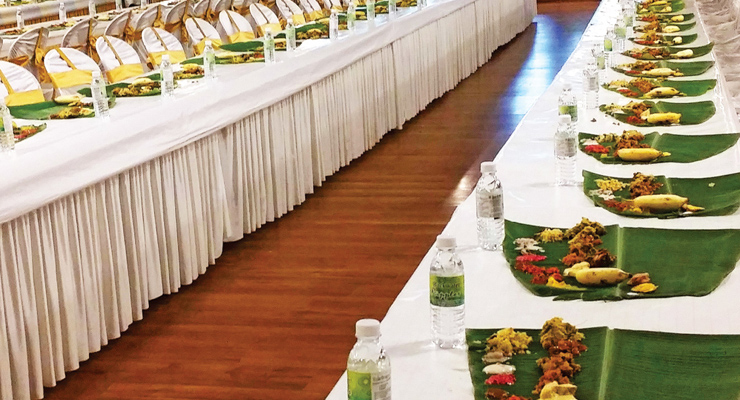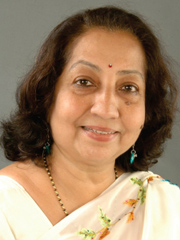
Most Keralites know what a Sadya is. For those who have no clue what it is, a Sadya is an elaborate meal served on festive occasions such as Onam, Vishu and family oriented occasions like marriage, birthday, naming ceremony of babies, housewarming etc in Kerala.
Sadya is served on a banana leaf cut to an appropriate size and is enjoyed with as much delight as it is served by people who are accustomed to serving the meal in a particular order. By particular order I mean really a certain fixed order starting with the pickles at one end and finishing with a spicy curry at the other end. Items like crispy banana wafers and papad are placed close to the pickles and you are welcome to start munching them if you are very hungry and you can't wait for the service to start.
In weddings the meal is served sometimes before the wedding ceremony takes place in the hall where a decorated platform is reserved for the ceremony and rows of chairs are placed around the platform for invitees to sit like an audience and watch the short formal ceremony with a prayer for the couple to live happily ever after.
Most times the meal is served immediately after the ceremony and the bride and bridegroom who have become man and wife are ceremoniously escorted to the table reserved for them to partake of the Sadya along with family members and invitees.
It is an amusement for the relatives of the newlywed couple to see how the two exchange glances and nudges while having the food.
When the Sadya is served before the ceremony it is a peaceful affair because there is ample time to consume the food and relish the taste and exchange comments about the items on the leaf. The guests have to wait anyway for the marriage ceremony as it is very uncivilized to leave without attending the real event to which you have been invited. The Sadya incidentally is always served in a hall that is adjoining the marriage hall and the entrance is often the exist as well.
The challenge that the entrance cum exit to the dining hall poses is not evident when the meal is served before the ceremony. It becomes a major challenge and hassle when the meal is served after the ceremony. Once the ceremony is over the seated invitees rise from the seats together and, with nothing other than the prospect of enjoying the Sadya on their minds, they head straight for the entrance cum exit like a human wave and what ensues is a sight that makes one wonder if there is a famine of the city.
It is in essence a tribute to the irresistible appeal of the Sadya. The tables are neatly arranged and benches or chairs are provided for the invitees to be comfortably seated and enjoy the Sadya. The banana leaves are also placed on the tables either open or folded and a glass of clean water is placed too on the table for the guest to sprinkle on the banana leaf and wipe it clean with his palm and to his satisfaction.

Once the guests are seated the serving begins. Nimble footed young men are usually employed to serve though women also can be employed. The important attribute required in a server is speed. How quickly can the dozen or more items in the meal be served in the right order is the criterion. The fluid items like parippu (daal), sambhar puliseri, are bought in small stainless steel buckets and served so quickly that anyone who is not accustomed to a Sadya can have a tough time getting the rice, which is the first item to be served in the form of a little mountain on the leaf, swiftly organized in parts for the different gravies to be mixed and eaten as they should be eaten. For instance, the daal should be blended into a portion of the rice with ghee that is casually dropped on the rice speedily by one server while another server ahead of him has already poured the yellow daal on the rice with equal speed. The daal (Parippu as it is called in Malayalam) which is the opening item sets the pace brilliantly as it has to be savoured with a crushed papad over it and the ghee dropped in blobs with a spoon. The daal is followed by sambhar served hot with a variety of vegetables and juicy drumsticks in it.
The sweet payasams (the kheers) are served in the middle of the course one after the other in quick succession on the banana leaf itself and not in bowls It is to be scooped deftly using the fingers and the palm of your hand and slurped and eaten with profound relish. It is a very tricky affair and it requires some skill to have it the way it should be had. It can drop and slide down to one’s elbow or just fall on the beautiful outfit or sari you are wearing. Similarly the rasam. If it is watery you can ask for it to be poured into a glass and that is if you have an empty glass on the table. In the absence of an empty glass on the table, you have no option but to receive the hot spicy liquid in your cupped palm and carefully and quickly slurp it down. In his autobiography, “The Substance and The Shadow”, the legendary Hindi film Thespian, Dilip Kumar, has described how he enjoyed a Tamilian sadya in Madras (now Chennai) in his own way when he was shooting for Ram aur Shyam. He describes gleefully how he made attempts to have the rasam over the rice. He describes how he made little mounts to arrest the flow of the rasam outside the banana leaf and succeeded.
The success of the Sadya is measured by a strange yardstick. If the guests rise from their seats belching loudly or softly it is assumed that the Sadya couldn’t have been better. If no belching is noticed or heard, it is a disgrace.
Such being the important of a Sadya in the Southern states of India, I was quite surprised when I heard very recently that a Sadya could be ordered to be delivered in a parcel by a restaurant when you don't have the patience or the desire to cook one in your own kitchen. I was indeed pleasantly surprised by an announcement that a restaurant in a Mumbai suburb was going for a reopening with a parcel service and the launch would start with a Sadya that could be ordered on phone or online.
I couldn’t figure out how a Malayalee Sadya could be parceled. I decided to give it a try. Who knows someone with an inventive mind would have found a way to parcel all the intriguing dishes and the rice and the papad and the payasams and the banana chips and the buttermilk and rasam and the banana along with the banana leaf with no mishaps.
As a matter of fact, I could recall the monotonous lunches that came to our house in my childhood from Kerala restaurant in our neighborhood when Amma had to go through a surgery and the surgeon advised complete bed rest for her. After some brave attempts at making sambar and spoiling the pressure cooker which exploded mildly with all the daal flying to the ceiling, our father thought it wise to arrange for the daily food service from the restaurant. The “meals” as it was called came in a stainless steel tiffin carrier which had six containers held together by a stand that got locked on top with a spoon. The containers contained all the vegetable side dishes and the sambar and buttermilk. The rice came in a separate parcel wrapped in a banana leaf softened on a hot tawa to make the folding easy.
On the first day we were quite delighted with the spread which looked and tasted good. On the second day we expected a different set of vegetables. But no luck. The same avial, the same sambar, the same rasam. On the third day it was again the same. When we found the same menu in the tiffin carrier on the fourth day, we decided to find out from the delivery boy whether we had made a mistake in our ordering of the “meals”. He assured us there was no mistake. He told us we were getting a mini sadya everyday and there would be no variety whatsoever. Seeing the expression of dismay on our faces the delivery boy gave us the idea not to order the “Sadya meals “but instead opt for individual items on menu such as biryani, curd rice etc.
We followed his advice and there was variety for some days. But the fact we realized and understood was that there was variety sans taste and relish in individual items.
The taste which can only be found in the combination of dishes imaginatively included in the Sadya spread, ranging from the pungent pickles to the sour rasam, puliseri and Kalan to the sweet payasams, bolis and tiny bananas, to the mild digestive effect of buttermilk served as the grand finale to the feast is the timeless value of a great sadya.
You will know what I mean when you are invited to Sadya by a Malayalee friend. It is as good as being invited to royal banquet.
A regal banquet is what Sadya means in simple language.
Long live the Sadya.

By Udaya Tara Nayar,
Former Editor of Screen Weekly & Advisory Board Member of Better Kitchen




Be the first one to post a comment